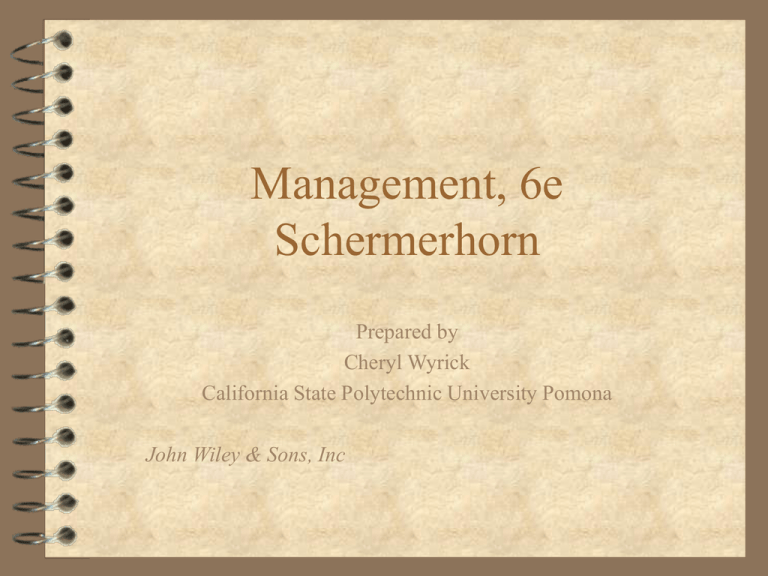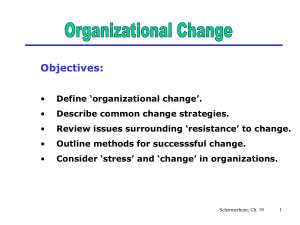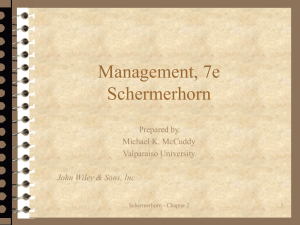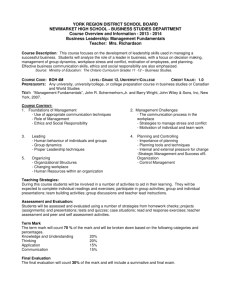
Management, 6e
Schermerhorn
Prepared by
Cheryl Wyrick
California State Polytechnic University Pomona
John Wiley & Sons, Inc
COPYRIGHT
Copyright 1999 © John Wiley & Sons, Inc. All rights reserved.
Reproduction or translation of this work beyond that named in
Section 117 of the United States Copyright Act without the express
written consent of the copyright owner is unlawful. Request for
further information should be addressed to the Permission
Department, John Wiley & Sons, Inc. The purchaser may make
back-up copies for his/her owner use only and not for distribution or
resale. The Publisher assumes no responsibility for errors,
omissions, or damages, cause by the use of these programs or from
the use of the information contained herein.
Chapter 11
Organizational Design and Work Processes
What are the essentials of organizational design?
How do contingency factors influence
organization design?
What are the major issues in subsystems design?
How can business processes be reengineered?
How is technology influencing organizational
design?
Schermerhorn -- Chapter 11
3
Organizational Design Essentials
Directions For Change
– shift from
• vertical to horizontal structure
• authority driven to task driven
Schermerhorn -- Chapter 11
4
Organizational Design Essentials
Bureaucratic Designs
– Bureaucracies
• based on
– logic
– order
– legitimate use of
formal authority
Schermerhorn -- Chapter 11
5
Organizational Design Essentials
Bureaucracies
– feature
• clear-cut division of labor
• strict hierarchy of authority
• formal rules and procedures
• promotion based on competency
Schermerhorn -- Chapter 11
6
Organizational Design Essentials
Mechanistic Designs
– highly bureaucratic
– more centralized authority
– many rules and procedures
– precise division of labor
– narrow spans of control
– formal means of coordination
Schermerhorn -- Chapter 11
7
Organizational Design Essentials
Adaptive Designs
– operate with minimum of
bureaucratic features
– encourage worker
empowerment
– based on team and network
structures
– operate with organic designs
Schermerhorn -- Chapter 11
8
Organizational Design Essentials
Organic Designs
– more decentralized authority
– fewer rules and procedures
– less precise division of labor
– wider spans of control
– more personal means of coordination
Schermerhorn -- Chapter 11
9
Contingency Factors &
Organizational Design
Environment
– certain
• relatively stable, predictable elements
– uncertain
• more dynamic, less predictable elements
Schermerhorn -- Chapter 11
10
Contingency Factors &
Organizational Design
Strategy
– “structure follows strategy”
• stable strategy is supported by
– bureaucratic organizations using mechanistic
designs
• growth oriented strategy is supported by
– adaptive organizations using organic designs
Schermerhorn -- Chapter 11
11
Contingency Factors &
Organizational Design
Technology
– combination of
knowledge, equipment,
and work methods used
to transform resource
inputs into organization
outputs
Schermerhorn -- Chapter 11
12
Contingency Factors &
Organizational Design
Core Manufacturing Technology
– small-batch production
• custom products made by highly skilled workers
– mass production
• large number of uniform products made in efficient manner
– continuous-process production
• few products made by continuously feeding raw materials
through a highly automated production system
Schermerhorn -- Chapter 11
13
Contingency Factors &
Organizational Design
Size and Life Cycle
– Organizational life cycle
•
•
•
•
Birth
Youth
Mid-life
Maturity
Schermerhorn -- Chapter 11
14
Contingency Factors &
Organizational Design
Managing bigness
– downsizing
– simultaneous structures
• combined mechanistic and
organic designs
– intraprenuership
Schermerhorn -- Chapter 11
15
Contingency Factors &
Organizational Design
People
– good organizational design
• supportive structure
– good “fit” between organization and people
Schermerhorn -- Chapter 11
16
Subsystems and
Organizational Design
Subsystem
– department or work unit headed by a manager
– operates as smaller part of larger organization
– serves the needs of larger organization
– ideally each subsystem supports other subsystems
Schermerhorn -- Chapter 11
17
Subsystems and
Organizational Design
Differentiation
– degree of difference between
internal components of the
organization
– sources of differences
•
•
•
•
time orientation
objectives
interpersonal orientation
formal structure
Schermerhorn -- Chapter 11
18
Subsystems and
Organizational Design
Integration
– level of internal coordination
– becomes harder to achieve with increased
differentiation
Schermerhorn -- Chapter 11
19
Work Process Design
Process reengineering
– systematic, complete analysis of work processes and
– design of new and better processes
Work Process
– related group of tasks that create value for the customer
Workflow
– movement of work through the manufacturing or
service delivery process
Schermerhorn -- Chapter 11
20
Work Process Design
Reengineering core processes
– Process value analysis
•
•
•
•
•
•
identify core processes
map core processes in respect to workflows
evaluate all tasks for core processes
search for ways to eliminate unnecessary tasks
search for ways to eliminate delays, errors, misunderstandings
search for efficiencies in how work is shared and
transferred
Schermerhorn -- Chapter 11
21
Technology and Operations Design
Manufacturing Applications
– lean production
• new technology and streamlined systems allow for fewer
workers and smaller inventories
– flexible manufacturing
• manufacturing processes can be changed quickly
– mass customization
• individualized products made as quickly as uniform products
Schermerhorn -- Chapter 11
22
Technology and Operations Design
High-technology operations management
– Work station advantages and applications
•
•
•
•
•
Computer-aided design (CAD)
Computer-aided manufacturing (CAM)
Computer-aided process planning
Computer numerical control
Group technology
Schermerhorn -- Chapter 11
23
Technology and Operations Design
Office systems and
support
– Electronic office
• utilize computers and
information technology
to:
– streamline work
– improve efficiencies
– overall performance
improvements in
office systems and
support functions
Schermerhorn -- Chapter 11
24












